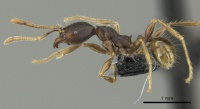Carebara silenus
| Carebara silenus | |
|---|---|

| |
| Scientific classification | |
| Kingdom: | Animalia |
| Phylum: | Arthropoda |
| Class: | Insecta |
| Order: | Hymenoptera |
| Family: | Formicidae |
| Subfamily: | Myrmicinae |
| Tribe: | Crematogastrini |
| Genus: | Carebara |
| Species: | C. silenus |
| Binomial name | |
| Carebara silenus (Smith, F., 1858) | |
| Synonyms | |
| |
Identification
Distribution
Latitudinal Distribution Pattern
Latitudinal Range: 5.79° to 3.7225°.
| North Temperate |
North Subtropical |
Tropical | South Subtropical |
South Temperate |
- Source: AntMaps
Distribution based on Regional Taxon Lists
Indo-Australian Region: Borneo, Indonesia, Malaysia, Singapore (type locality).
Oriental Region: Sri Lanka, Thailand.
Distribution based on AntMaps
Distribution based on AntWeb specimens
Check data from AntWeb
Countries Occupied
| Number of countries occupied by this species based on AntWiki Regional Taxon Lists. In general, fewer countries occupied indicates a narrower range, while more countries indicates a more widespread species. |

|
Estimated Abundance
| Relative abundance based on number of AntMaps records per species (this species within the purple bar). Fewer records (to the left) indicates a less abundant/encountered species while more records (to the right) indicates more abundant/encountered species. |

|
Biology
Life History Traits
- Mean colony size: 100,000 (Moffet, 1988; Beckers et al., 1989)
- Foraging behaviour: group hunter (Moffet, 1988; Beckers et al., 1989)
Castes
Images from AntWeb
 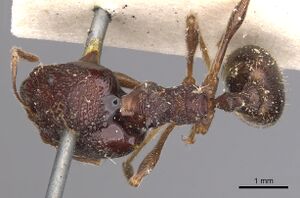  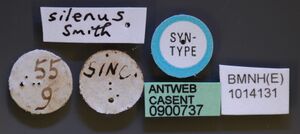
| |
| Syntype of Pheidologeton silenus. Worker (major/soldier). Specimen code casent0900737. Photographer Will Ericson, uploaded by California Academy of Sciences. | Owned by NHMUK, London, UK. |
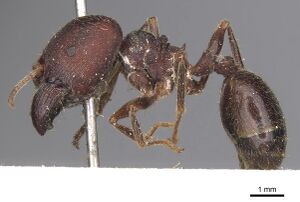   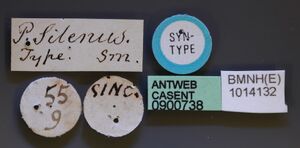
| |
| Syntype of Pheidologeton silenus. Worker (major/soldier). Specimen code casent0900738. Photographer Will Ericson, uploaded by California Academy of Sciences. | Owned by NHMUK, London, UK. |
Nomenclature
The following information is derived from Barry Bolton's Online Catalogue of the Ants of the World.
- silenus. Pheidole silenus Smith, F. 1858b: 176 (s.w.) SINGAPORE.
- Type-material: 2 syntype workers.
- [Note: 1w major syntype OXUM, 1w major syntype BMNH (Bolton (unpublished notes) 1978).]
- Type-locality: Singapore: (no further data).
- Type-depositories: BMNH, OXUM.
- Combination in Pheidologeton: Mayr, 1862: 751;
- combination in Carebara: Fischer, et al. 2014: 72.
- Status as species: Mayr, 1862: 751; Roger, 1863b: 30; Mayr, 1863: 442; Mayr, 1865: 103; Smith, F. 1871a: 332; Dalla Torre, 1893: 73; Emery, 1900d: 688; Forel, 1903a: 691; Forel, 1911d: 387 (redescription); Forel, 1911e: 268; Forel, 1913k: 56; Emery, 1924d: 213; Chapman & Capco, 1951: 160; Ettershank, 1966: 119; Bolton, 1995b: 333; Jaitrong & Nabhitabhata, 2005: 36; Pfeiffer, et al. 2011: 50; Dias, R.K.S. et al. 2020: 66; Khachonpisitsak, et al. 2020: 83; Wang, W.Y., Soh, et al. 2022: 73.
- Senior synonym of speculifrons: Ettershank, 1966: 119; Bolton, 1995b: 333.
- Distribution: Indonesia (Sumatra), Malaysia (Peninsula, Sarawak), Singapore, Sri Lanka, Thailand.
- speculifrons. Amauromyrmex speculifrons Wheeler, W.M. 1929b: 1, fig. 1 (w.) BORNEO (East Malaysia: Sarawak).
- Type-material: 7 syntype minor workers.
- Type-locality: Malaysia: Sarawak, Mt Poi, 8000 ft (E. Mjöberg).
- Type-depository: MCZC.
- Status as species: Chapman & Capco, 1951: 155.
- Junior synonym of silenus: Ettershank, 1966: 119; Bolton, 1995b: 333.
Unless otherwise noted the text for the remainder of this section is reported from the publication that includes the original description.
Description
Worker
Wheeler (1929), for Amauromyrmex speculifrons - Length, 2.5-3.5 mm.
Head slightly longer than broad, as broad in front as behind, with evenly convex lateral borders and concave posterior border; occipital border marginate; vertex and gula in profile flattened, especially behind. Eyes consisting of less than a dozen unequal facets. Clypeus somewhat flattened in the middle, the anterior border with a small, indistinct median emargination. Mandibles with convex external borders, 6-toothed, the two apical teeth and the basal tooth large, the three remaining teeth very small, separated by a diastema from the second tooth and diminishing in size towards the base. Antennae slender; scapes straight, slightly enlarged towards their tips, which extend somewhat beyond the posterior corners of the head; first funicular joint about three times as long as broad; joints 2-8 distinctly longer than broad; club somewhat shorter than the remainder of the funiculus, its two joints rather slender, the basal narrower than the apical and about three-fourths as long. Thorax slender, decidedly narrower than the head, broadest through the pronotum; the meso- and epinotum narrow; pronotum slightly longer than broad, evenly elliptical from above, its dorsal surface depressed and moderately flattened, very feebly convex in profile; the pair of spines rather blunt, somewhat longer than broad at their bases, flattened and projecting outward and slightly forward and upward. From the base of each spine backward, the sides of the pronotum are distinctly marginate. The mesonotum seen from above is rectangular and parallel-sided, longer than broad; it gradually slopes downward and backward to the mesoepinotal constriction. Epinotum broader than the mesonotum, somewhat broader than long; its base moderatly convex in profile, longer than the declivity, which is vertical, marginate on the sides and rather concave medially; the spines are as long as their distance apart at the base, slender and acute, directed upward and outward and with their tips curved forward. Petiole very slender, nearly three times as long as broad, gradually broadened behind where it bears a rounded-conical node, through which the petiole is as high as the length of the peduncle; ventral surface evenly convex and finely crenulate in profile. Postpetiole fully half again as broad as the petiole, nearly one and one-half times as long as broad, subelliptical in profile, evenly convex above but decidedly lower than the petiolar node. Gaster smaller than the head, elongate elliptical, narrowed antteriorly. Distal halves of femora decidedly thickened, their bases and the tibial slender.
Feebly shining; mandibles subopaque, sharply and densely striate; front of head over a squarish area bounded anteriorly by the frontal carinae and as far back as the posterior fourth, very smooth and shining; remainder of head, thorax and petiole sharply and regularly reticulate-rugulose, the gula anteriorly and the cheeks with longitudinal rugre. The latter spread out fan-wise around the antennal foveae. There are rugae also on the thoracic dorsum but they are irregular, loose and vermiculate; sides of epinotum with several longitudinal rugae. Petiole more finely reticulate than the thorax. Postpetiole, gaster and legs shining but with rather uneven surface and with sparse piligerous punctures. Scapes and coxae indistinctly shagreened, less shining than the legs.
Hairs yellowish, coarse, sparse, pointed, of very uneven length; long and erect on the dorsal surface, especially on the pronotum, clypeus and gaster; shorter and oblique on the legs and scapes.
Mandibles, head, thorax and coxae deep reddish brown; petiole, post petiole, gaster, legs and antennae paler and more yellowish brown; first gastric segment, except anteriorly, dark brown.
Type Material
The following notes on F. Smith type specimens have been provided by Barry Bolton (details):
Pheidole silenus
One syntype worker major in Oxford University Museum of Natural History, one syntype worker major in The Natural History Museum. Both labelled “SING.”
Description
References
- Beckers R., Goss, S., Deneubourg, J.L., Pasteels, J.M. 1989. Colony size, communication and ant foraging Strategy. Psyche 96: 239-256 (doi:10.1155/1989/94279).
- Ettershank, G. 1966. A generic revision of the world Myrmicinae related to Solenopsis and Pheidologeton (Hymenoptera: Formicidae). Aust. J. Zool. 14: 73-171 (page 119, Senior synonym of speculifrons)
- Fischer, G., Azorsa, F. & Fisher, B.L. 2014. The ant genus Carebara Westwood (Hymenoptera, Formicidae): synonymisation of Pheidologeton Mayr under Carebara, establishment and revision of the C. polita species group. ZooKeys 438: 57–112.
- Khachonpisitsak, S., Yamane, S., Sriwichai, P., Jaitrong, W. 2020. An updated checklist of the ants of Thailand (Hymenoptera, Formicidae). ZooKeys 998, 1–182 (doi:10.3897/zookeys.998.54902).
- Mayr, G. 1862. Myrmecologische Studien. Verh. K-K. Zool.-Bot. Ges. Wien 12: 649-776 (page 751, Combination in Pheidologeton)
- Smith, F. 1858b. Catalogue of hymenopterous insects in the collection of the British Museum. Part VI. Formicidae. London: British Museum, 216 pp. (page 176, soldier, worker described)
- Wang, W.Y., Soh, E.J.Y., Yong, G.W.J., Wong, M.K.L., Benoit Guénard, Economo, E.P., Yamane, S. 2022. Remarkable diversity in a little red dot: a comprehensive checklist of known ant species in Singapore (Hymenoptera: Formicidae) with notes on ecology and taxonomy. Asian Myrmecology 15: e015006 (doi:10.20362/am.015006).
References based on Global Ant Biodiversity Informatics
- Berghoff S.M., U. Maschwitz, and K.E. Linsemair. 2003. Hypogaeic and epigaeic ant diversity on Borneo: evaluation of baited sieve buckets as a study method. Tropical Zoology 16: 153-163.
- Chapman, J. W., and Capco, S. R. 1951. Check list of the ants (Hymenoptera: Formicidae) of Asia. Monogr. Inst. Sci. Technol. Manila 1: 1-327
- Dias R. K. S. 2002. Current knowledge on ants of Sri Lanka. ANeT Newsletter 4: 17- 21.
- Emery C. Formiche raccolte da Elio Modigliani in Sumatra, Engano e Mentawei. Annali del Museo Civico di Storia Naturale 40: 661-722.
- Emery, C.. "Formiche raccolte da Elio Modigliani in Sumatra, Engano e Mentawei." Annali del Museo Civico di Storia Naturale Giacomo Doria (Genova) (2) 20, no. 40 (1900): 661-722.
- Ettershank G. 1966. A generic revision of the world Myrmicinae related to Solenopsis and Pheidologeton (Hymenoptera: Formicidae). Aust. J. Zool. 14: 73-171.
- Forel A. 1903. Les Formicides de l'Empire des Indes et de Ceylan. Part X. J. Bombay Nat. Hist. Soc. 14: 679-715.
- Forel A. 1911. Die Ameisen des K. Zoologischen Museums in München. Sitzungsber. Math.-Phys. Kl. K. Bayer. Akad. Wiss. Münch. 11: 249-303.
- Jaitrong W., and T. Ting-Nga. 2005. Ant fauna of Peninsular Botanical Garden (Khao Chong), Trang Province, Southern Thailand (Hymenoptera: Formicidae). The Thailand Natural History Museum Journal 1(2): 137-147.
- Kishimoto-Yamata K., F. Hyodo, M. Matsuoka, Y. Hashimoto, M. Kon, T. Ochi, S. Yamane, R. Ishii, and T. Itioka. 2012. Effects of remnant primary forests on ant and dung beetle species diversity in a secondary forest in Sarawak, Malaysia. Journal of Insect Conservation DOI 10.1007/s10841-012-9544-6
- Kugler C. 1986. Stings of ants of the tribe Pheidologetini (Myrmicinae). Insecta Mundi 1: 221-230.
- Pfeiffer M., D. Mezger, and J. Dyckmans. 2013. Trophic ecology of tropical leaf litter ants (Hymenoptera: Formicidae) - a stable isotope study in four types of Bornean rain forest. Myrmecological News 19: 31-41.
- Pfeiffer M.; Mezger, D.; Hosoishi, S.; Bakhtiar, E. Y.; Kohout, R. J. 2011. The Formicidae of Borneo (Insecta: Hymenoptera): a preliminary species list. Asian Myrmecology 4:9-58
- Wheeler W. M. 1929. Three new genera of ants from the Dutch East Indies. American Museum Novitates 349: 1-8.
- Yamane S. 2003. Preliminary survey on the distribution pattern of southeast Asian Pheidologeton species (Hymenoptera: Formicidae). Pp. 73-86 in: Mohamed, M.; Fellowes, J. R.; Yamane, S. (eds.) 2003. Proceedings of the 2nd ANeT workshop and seminar. Kota Kinabalu: Universiti Malaysia Sabah
